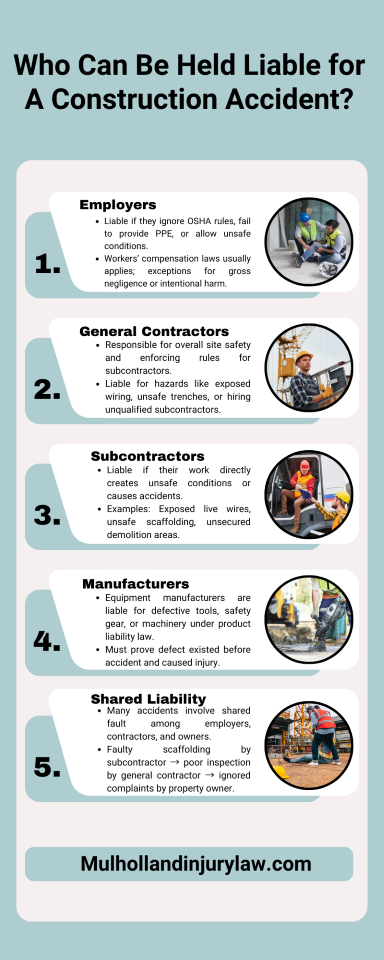Construction sites are some of the most dangerous workplaces in the United States. With heavy machinery, hazardous materials, elevated work areas, and multiple contractors on-site, accidents can happen in seconds — and the results are often life-changing.
When a construction accident occurs, one of the most important questions is: Who can be held legally responsible for the injury?
Understanding liability is crucial, because identifying the correct party (or parties) ensures injured workers and bystanders can recover fair compensation for medical bills, lost wages, and long-term damages.

- 1. Employers / Construction Companies
- 2. General Contractors
- 3. Subcontractors
- 4. Property Owners
- 5. Equipment Manufacturers
- 6. Architects & Engineers
- 7. Third-Party Vendors & Suppliers
- 8. Multiple Parties (Shared Liability)
- How Liability is Determined?
- Protecting Your Rights After a Construction Accident
- Final Thoughts
1. Employers / Construction Companies
When they’re liable?
If your direct employer fails to follow OSHA safety regulations, does not provide proper protective equipment, or ignores hazardous conditions, they may be partially or fully responsible for your injuries.
Examples:
- Failing to provide fall harnesses when working on scaffolding.
- Not training workers on safe equipment operation.
- Ignoring repeated reports about defective tools.
Legal Note:In most cases, employees can’t sue their direct employer due to workers’ compensation laws, but employers still play a role in claims through workers’ comp benefits. However, if gross negligence or intentional harm is involved, legal exceptions may apply.
2. General Contractors
Role in liability:
General contractors are often responsible for overall site safety, even if they didn’t directly cause the accident. They must ensure subcontractors follow safety protocols and that the site complies with legal requirements.
They can be liable for:
- Failing to enforce safety rules across the site.
- Not addressing hazards like unprotected trenches or exposed wiring.
- Hiring subcontractors without proper licensing or insurance.
3. Subcontractors
When they’re liable?
If a subcontractor’s work creates unsafe conditions or directly causes an accident, they may be held responsible.
Example scenarios:
- An electrical subcontractor leaves live wires exposed.
- A scaffolding company erects unsafe structures.
- A demolition team fails to secure a work zone, causing debris to injure someone.
4. Property Owners
Why they might be responsible?
If the property owner knew (or should have known) about dangerous site conditions and failed to warn workers or take action, they could be held liable.
Typical examples:
- Landowners allowing work to proceed on unstable ground.
- Not disclosing the presence of hazardous materials like asbestos.
- Allowing work during extreme weather without safety accommodations.
5. Equipment Manufacturers
When product liability applies?
If defective equipment causes an accident — for example, a malfunctioning crane, a faulty safety harness, or a tool that breaks under normal use — the manufacturer or distributor may be legally liable.
Key points:
- Claims often fall under product liability law.
- You must prove the defect existed before the accident and directly caused your injury.
- Sometimes, rental companies that fail to maintain equipment can also share liability.
6. Architects & Engineers
Their role in liability:
If an accident occurs because of a design flaw, poor engineering judgment, or failure to adhere to building codes, architects or engineers involved in the project may be held responsible.
Example cases:
- A structural engineer approves a faulty load-bearing design that collapses.
- An architect’s plans fail to include adequate safety barriers for elevated work areas.
7. Third-Party Vendors & Suppliers
If outside vendors deliver unsafe materials, fail to follow safety protocols on-site, or create hazards during delivery, they may be partly liable.
8. Multiple Parties (Shared Liability)
In many construction accident cases, more than one party shares responsibility. For example:
A subcontractor sets up faulty scaffolding → the general contractor fails to inspect it → the property owner ignores complaints about instability.
This scenario could lead to claims against all three.
How Liability is Determined?
Courts and insurance companies typically consider:
- OSHA violations and workplace safety records.
- Contracts outlining site safety responsibilities.
- Incident reports and witness statements.
- Expert testimony about industry safety standards.
Protecting Your Rights After a Construction Accident
If you’re injured, your actions in the hours and days afterwards can affect your ability to claim compensation:
- Report the accident immediately to your employer or site manager.
- Seek medical attention even if injuries seem minor — documentation is key.
- Document the scene with photos, videos, and witness information.
- Do not sign statements or accept settlements without legal advice.
- Contact a construction accident lawyer to investigate and identify all possible liable parties.
Final Thoughts
Construction accident liability can be complex because so many parties are involved in site operations. The best way to secure your rights — and fair compensation — is to work with an attorney who can trace responsibility through contracts, safety obligations, and regulatory compliance.
By holding all liable parties accountable, you not only recover what you’re owed but also help improve safety standards for everyone on the job site.
If you need help in getting your case evaluated, Mulholland Injury Law can help.

